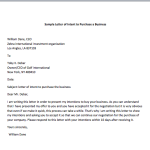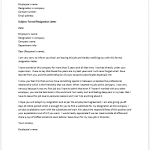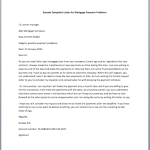In simple terms, a business letter can be referred to as a business introduction letter, where a product, company or service is suggested to clients, prospective customers, or business associates. Fundamentally, these come into plays a long-lasting relationship is borne out of something. This all depends on the context of the business; a newly launched business email might wish to contact its possible clients, or an existing firm might want to invite people to purchase a new service. The introduction letter, if designed right, can facilitate people and possibilities.
The goal of a business letter is to instill trust, arouse curiosity and entice the recipient into communication. This letter is designed to introduce key information about the business while also enhancing why the recipient should engage with this business. A good introduction letter is precise and precise and respectful of the format but still professional in approach, very clear and very enthusiastic at the same time. This is done by taking into account what the recipient wants and establishing the company as a useful contact, which both promotes the brand and facilitates networking.
Types of Business Introduction Letters
Several functions of a business introduction letter will depend on the recipients of the letter as well as its purpose. From aspiring clients to collaborators and even to the sponsors, each letter will utilize a particular format and resources that will help achieve its intended purpose. Regardless of the letter, the tone, the structure and scope of information will differ in the case of each type of possible letter.
Business-to-Business (B2B) Introduction Letters
A B2B written communication between two business organizations is called a business letter. In this case, a business introduction letter is written from one company to another for purposes of initiating or facilitating relationship. For example, it is used to present a new product, invite cooperation, or suggest an advantageous service. These aspects highlight the importance and promise to achieve the maximum possible compactness and rationality and providing reasons for the receiving party to accept the proposed cooperation by showing how it fits in its business and meets its objectives.
Business-to-Consumer (B2C) Introduction Letters
A B2C business letter is written to single customers and explains what the company has to offer. The letters can be part of an advertising campaign, promotion of discounts, or introduction of a new product. A B2C business introduction letter, however, is emotional, beneficial and simple in its approach to the client, with the intention of promoting quick usage, unlike a B2B business letter that is oriented towards strategic advantages.
Introduction Letters for Partnerships and Collaborations
A number of companies interested in forming joint ventures, finding sponsors, or collaborating with other companies write introduction letters that serve to make such connections possible. The objectives, ethics and benefits of working with another entity are often contained in these forms of business material. The intention of the business letter is to create applicable trust and explain manner in which each side in growth of ways making use of the relationship.
Every type of business letter demands a different way of writing which will depend on whom it is addressed to. Writing a business, for example, structured and coming up with an didn’t during letter, while it maximizes a readers attention, decreases the chance of receiving a positive response to mail.
Free Sample Business Introduction Letters
Here are previews and download links for these templates,
Essential Components of a Business Introduction Letter
In order to convey professionalism, credibility, as well as purpose in a business letter, a person must ensure that the business introduction letter is well-structured. It should be succinct and to the point, but creative enough in its form besides using polite language. The different sections of the letter are important in making the reader comprehend the content as well as visualize the worth of action.
Company Information and Background
One should start off by including simple information about the company such as it’s name, what industry it is in and a short history about it. The rationale behind this is to remove all doubts that the recipient might have regarding the purposes of the business letter. Outline of the company’s origin, capabilities and accomplishments is important to earn recipient’s confidence.
Purpose of the Letter
A clear purpose of the letter is essential to make sure that the recipient understands why the letter is being written. When writing to introduce a new business or product or suggest any collaboration, the purpose is often mentioned from the very beginning. Since a business letter is written to make a point it is good to start with that point in a manner which immediately captures the attention of the reader.
Value Proposition and Unique Selling Points
A strong business cover letter emphasizes the unique value of the business, product, or service being introduced. Showing the benefit of the relationship to the Dean increases motivation to maintain it. Even if it is referring to saving money, technology, or customer service, their commitment to excellence needs to shine through in the business letter of such an organization.
Call to Action and Contact Information
It is imperative to induce the recipient to take the next step. A business letter written in the heart creates a compelling call to action encouraging the receiver to fix a meeting, surf the internet or call for more information. Specifying an active person with a title or even only a person’s name allows constraint bridging. A good result in any business introduction letter is making closing statements, which are grounded in the letter’s aim, and gratitude to the recipients for their attention.
Formatting and Style Guidelines
In writing a business letter, an introduction must be written as a business introduction letter and neatness in style is paramount. Thus, the overall structure of the business letter needs to be well referenced and contain appropriate sections designed to guide one reader through all the stages from start to the end. Additionally, a properly presented introduction letter is credible to the reader; it can bring the subject to the reader’s attention and to a healthy extent solve stereotype problems if any.
Professional Tone and Language
The tone in the business letter should be positive, and formal, and yet warm and encouraging. It is essential to use good courteous language and express the message in a way that represents the company. Do not use difficult words, industry terms, or any other technical phrasing that is likely to cause misunderstanding on the part of the recipient. It is better to stick to straight forward language without any embellishments for the sake of making the point clear. To put it in simpler words, a business introduction letter does not have to be very composed and may have an element of chat and this will make it more pleasant and even receptive.
Proper Structure and Layout
The letter must follow the official business letter format, complete with a header containing the sender’s information, dates, and the recipient’s information. Each of these sections must be well separated using clear paragraphs. In the first paragraph, the intent of the letter must be clear and explained. This should be followed by more points about the same topic in the next paragraph and a very good conclusion to the letter, usually ending with a request to do something. This is important when writing a letter, as it ensures that the layout is neat and the reader gets the important points in the shortest time possible.
Length and Conciseness
One should not write lengthy business letter, the introduction business introduction letter must be short and limit one page. In case the letter is unnecessarily extensive, reader’s interest resolution will drop. All the paragraphs in the letter have to have a purpose and make any details that do not achieve that purpose be left out. Brief short sentences are very helpful since they 쉽게해서 can help one to learn the or catch the major the the corpus. Good letter structuring and rounds of a message that has got major marks of communication is easier to remember and will most likely lead to contacting the person more.
Common Mistakes to Avoid in Business Introduction Letters
Writing a business letter is a vital means of building bridges and promoting cooperation among stakeholders. Yet, some flaws in its content could compromise its purpose, making potential partners or customers ignore it. Therefore, it is important to net such mistakes and try and be as formal, concise, and effective as possible in the business introduction letter.
Overly Generic Content
A common error in crafting a business letter is to utilize general information, which is not exactly client specific. This happens when the exact same templates are dispatched to different addressees containing no elements which address their needs or interests. Without addressing the intended audience, the communication inevitably becomes uncompelling. Therefore, an effective business introduction letter makes assumptions about the recipient and that research on a particular business or organization has been carried out. Customization fosters a sense of warmth and greatly improves the chances of a favorable reply.
Lack of Clarity and Purpose
An inadequately organized business letter which does not reach its intention at first may create confusion to the receiver. A reader who fails to understand the content of the letter so outlays or even reads less. The paragraph should quickly address the issue being sent with the letter and the usefulness to the recipient of the products, services or collaboration in progress. The opening should be able to state its purpose as it gets to the reader’s mind.
Failure to Highlight Value
An introduction letter should emphasize the value the sender brings to the recipient. Simply stating what the company does without explaining how it benefits the recipient can make the letter unpersuasive. Highlighting unique selling points, key achievements, or competitive advantages ensures that the reader sees a compelling reason to continue the conversation. Demonstrating how the business solves a problem or meets a need strengthens the impact of the letter.
Weak or Missing Call to Action
It’s common to see a business letter with an unclear course of action at the end of the message. If no specific thing is met, the reader can often wonder what to do next. Almost every business introduction letter, however, be it a request for a meeting, a proposal to call a specified number or visit a website, has a simple and effective call to action. Professional closings also help in concluding the communication on a more interesting note, besides merely pouring out words on a piece of paper.
Neglecting Proofreading and Formatting
Business communication skills always remain incomplete without writing skills. Despite extra efforts of spending resources to write correct business letter, effective communication would never count for the particular audience in case an introduction letter contains many grammar errors or is poorly organized. First of all, structure and appearance are very important so that an introduction letter appears prim and proper. Since such contents are health at both ends, those who will assess the contents of the introduction letters will depend on the contents as portrayed in the letter.
Keep in touch for future updates on this topic to grab more free templates.






































